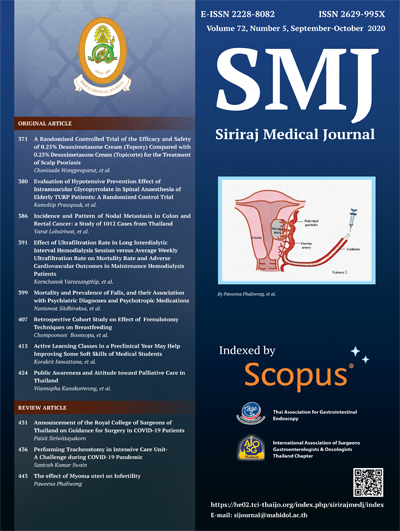Incidence and Pattern of Nodal Metastasis in Colon and Rectal Cancer: a Study of 1012 Cases from Thailand
DOI:
https://doi.org/10.33192/Smj.2020.52Keywords:
Colon cancer, rectal cancer, nodal metastasis, lymph node ratio, ThailandAbstract
Objective: Lymph node (LN) metastasis is a key to determine prognosis and adjuvant treatment for resectable colorectal cancer. This study aimed to determine and compare the incidence and pattern of LN metastasis between colon cancer and rectal cancer.
Methods: Medical and pathological reports of patients with stage I-III colorectal adenocarcinoma undergoing oncological resection between 2009 and 2013 at the Faculty of Medicine Siriraj Hospital were reviewed. The incidence and pattern of LN metastasis related to tumor staging between colon cancer and rectal cancer were analyzed.
Results: This study included 1012 cases (502 colon cancer and 510 rectal cancer). Compared with rectal specimens, colonic specimens had a larger tumor size (5.8 cm vs 5.0 cm; P<0.001), more T4 lesion (24% vs 6.3%; P<0.001) and more LNs harvested (24 vs 18; P<0.001). Nodal metastases were found in 552 specimens (54.5%). The rate of LN metastasis was 14.3% for T1 tumors, 25.6% for T2 tumors, 61.2% for T3 tumors, and 65.6% for T4 tumors. There was no significant difference in the overall rate of nodal metastasis between colon cancer and rectal cancer (52.6% vs 56.5%; P=0.22), but rectal cancer had more N2 staging (31% vs 22.5%; P=0.002). Rectal cancer yielded more median number of positive LN (4 vs 3; P=0.002) with a greater LN ratio (0.22 vs 0.12; P<0.001) than colon cancer. Based on the depth of tumor invasion, T3 rectal cancer had a significantly higher rate of LN metastasis (66.8% vs 55.7%; P=0.004) and a greater LN ratio (0.23 vs 0.10; P<0.001) than T3 colon cancer.
Conclusion: Although colon cancer had a larger tumor size and a higher percentage of deeper invasion, rectal cancer were associated with a higher number of positive LN, more N2 status and a greater LN ratio - especially T3 lesion.
Downloads
Published
How to Cite
Issue
Section
License
Authors who publish with this journal agree to the following conditions:
Copyright Transfer
In submitting a manuscript, the authors acknowledge that the work will become the copyrighted property of Siriraj Medical Journal upon publication.
License
Articles are licensed under a Creative Commons Attribution-NonCommercial-NoDerivatives 4.0 International License (CC BY-NC-ND 4.0). This license allows for the sharing of the work for non-commercial purposes with proper attribution to the authors and the journal. However, it does not permit modifications or the creation of derivative works.
Sharing and Access
Authors are encouraged to share their article on their personal or institutional websites and through other non-commercial platforms. Doing so can increase readership and citations.















